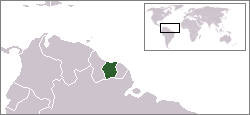Suriname
The Republic of Suriname (also spelled Surinam) is a country in northern South America, in between French Guiana to the east and Guyana to the west. The southern border is shared with Brazil and the northern border is the Atlantic coast.
| ||||
| National motto: Justitia - Pietas - Fides (Latin: Justice - Piety - Loyalty) | ||||
 | ||||
| Official language | Dutch | |||
| Capital | Paramaribo | |||
| President | Ronald Venetiaan | |||
| Area - Total - % water | Ranked 90th 163,270 km² 1.10% | |||
| Population
- Density | Ranked 163rd
2.66/km² | |||
| Independence
- Date | From the Netherlands
November 25, 1975 | |||
| Currency | Suriname Guilder | |||
| Time zone | UTC -4 | |||
| National anthem | God zij met ons Suriname | |||
| Internet TLD | .SR | |||
| Calling Code | 597 | |||
History
Main article: History of Suriname
Though Dutch traders had established several colonies in the Guiana region before, the Dutch did not get hold of what is now Suriname until the Treaty of Breda, settling the end of the Second Anglo-Dutch War.
After becoming an autonomous part of the Kingdom of the Netherlands in 1954, independence was granted in 1975. A military regime led by Desi Bouterse ruled the country in the 1980s, until democracy was re-established in 1988.
Politics
Main article: Politics of Suriname
Suriname is a democracy based on the 1987 constitution. The government's legislative branch is the National Assembly, consisting of 51 members. These members are elected every five year.
The National Assembly elects the head of the executive branch, the president, by a two-third majority. If no candidate achieves such a majority, the president is elected by the People's Assembly, a 340 member institute consisting of the National Assembly and regional representatives.
Districts
Main article: Districts of Suriname
Suriname is divided into ten districts:
Geography
Main article: Geography of Suriname
Suriname is the smallest country in South America (not counting French Guiana, as this is part of France). It is situated on the Guiana Shield, the highest point being the Julianatop (1,286 m above sea level). The land can be artificially divided into two parts. The northern, coastal area has been cultivated, and most of the population lives here. The southern part consists of sparsely inhabited tropical rainforest.
Lying near the equator, the climate in Suriname is tropical, and temperatures do not vary a lot throughout the year. The year has two rainy seasons, from December to early February and from late April to mid-August.
Located in the north-east of the countries is the W.J. van Blommesteinmeer, a large reservoir lake, created in 1964 by a dam (Brokopondo project).
Economy
Main article: Economy of Suriname
The Surinamese economy is very dependent of other countries, its main trade partners being the Netherlands, the United States and countries in the Caribbean.
Main export products are bauxite and sugar, and Suriname has some oil and gold reserves. About a quarter of the people work in the agricultural sector.
Demographics
Main article: Demographics of Suriname
The Surinamese population is made up of several minority groups. The largest part is formed by the Hindustani, descendants of 19th century immigrants from India, about 37% of the population. The Creole, mixed white and black form about 31%, while the Javanese ("imported" from the former Dutch East Indies) and Maroons (descendants of escaped African slaves) make up 15 and 10 percent, respectively. The remainder is formed by Indians, Chinese and whites.
Because of the great number of ethnic groups in the country, there is no main religion. Most of the Hindustani are Hindu, but Islam and Christianity are also widespread.
While Dutch is still the official language of Suriname, Sranang Tongo, originally a Creole language, is considered the lingua franca. The Surinamese of Asian descent often also speak their own languages.
Culture
Main article: Culture of Suriname
Due to the mix of population groups, the Surinamese culture is very diverse.
Miscellaneous topics
- Communications in Suriname
- Transportation in Suriname
- Military of Suriname
- Foreign relations of Suriname
External links
- ANDA Suriname - Surinamese portal (in Dutch)
